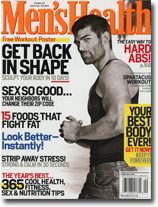In the fitness world, certain truths are held to be self-evident: Big lifts produce big gains, greater intensity fuels greater results, and less rest equals less fat and more strength. But science is now finding that many of these hard-and-fast muscle rules are not as immutable as we once thought.
"We're a lot smarter than we were even five years ago," says Bill Hartman, C.S.C.S., co-owner of Indianapolis Fitness and Sports Training. "Researchers and trainers are all starting to agree on what works and what doesn't."
The guessing game, in other words, is finally coming to an end. Read on to discover how the nation's top fitness coaches are incorporating lab-tested strength secrets into their workout plans, and how you can do the same to lift more weight, build more muscle, and lose those 10 extra pounds you've been complaining about since college. The path to the body you've always wanted starts here.
New Way /// Warm Up with Jumps
There is a reason why sprinters hop a few times before stepping into the starting blocks. Practice jumps kickstart the central nervous system, helping to activate more muscle fibers.
"The name for this neuromuscular priming is post-activation potentiation (PAP)," says Tony Gentilcore, C.S.C.S., co-owner of Cressey Performance in Hudson, Massachusetts. "And it's a key to greater strength both in and out of the gym."
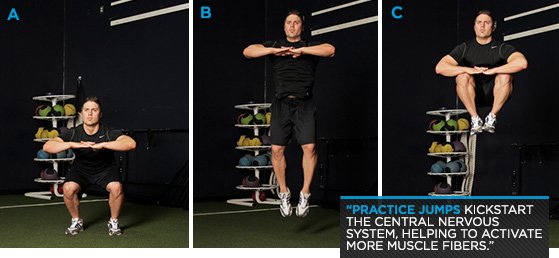
Consider this: Separate studies published in the Journal of Strength and Conditioning Research show that inducing PAP through jumps can help you leap more than seven percent higher and squat nearly 18 more pounds.
Apply It: For an immediate boost prior to a lower-body exercise, do three quick countermovement jumps: Push your hips back, bend your knees, and leap vertically. For upper-body moves, Gentilcore recommends a single, extra-heavy rep at the beginning of an exercise. "It fires up your nervous system and makes the subsequent reps feel significantly lighter."



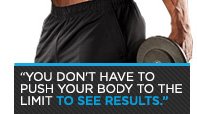
New Way /// Do Less Work, Better
You don't have to push your body to the limit to see results, says Martin Rooney, C.S.C.S., CEO of Training for Warriors. "Training eventually becomes less effective as you tire and your form breaks down," he says.
After that threshold, gains dwindle and injury risk increases. The key is to figure out the dose that helps you meet your goals without jeopardizing your health.
Apply It: Don't do more than a total of 22 good sets in a workout if you're looking to bulk up, says Rooney. Also, limit yourself to 4 sets per exercise. Researchers in Australia found that more than 4 sets offers diminishing returns.
New Way /// Go Light to Grow Big
"High weight, low reps" is the classic mantra of men who are trying to pack on size and strength.
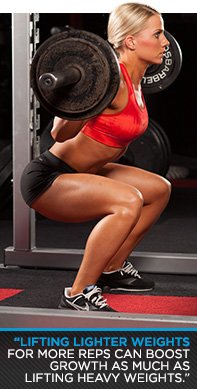
But a new study in the Journal of Applied Physiology found that lifting lighter weights for more reps—3 sets of up to 30 reps—can boost growth as much as lifting heavy weights in the 8-12-rep range.
"As long as your muscles reach fatigue, they'll grow," says John Romaniello, N.S.C.A.-C.P.T., owner of Roman Fitness Systems. "And some muscles, like those in your lower body, respond better to high reps."
Apply It: Do "breathing reps" for several of your lifts. Load a bar with a weight you can squat, press, or lift 12-15 times, and do those reps.
Without letting go of the bar, set it down, take two breaths, and do 1-or-2 more repetitions.
Continue the process until you reach 20 reps. That's 1 set; do 3 sets total.
"Including both high- and low-rep sets in your workouts ensures that you hit both your fast-and your slow-twitch muscle fibers," says Romaniello.
New Way /// Haul More Weight
Most men are accustomed to lifting, pushing, and pressing heavy loads. But when asked to carry one—whether it's a sandbag, kettlebell, or air conditioner—many become a stumbling mess after a few paces.
"They challenge your entire body, especially your lateral core strength, which is critical for everything from fast cuts to powerful serves," says Stuart McGill, Ph.D., author of the seminal study on the subject, published in the Journal of Strength and Conditioning Research. That's because "loaded carries" simultaneously test your stability, mobility, balance, and grip while keeping your muscles under constant tension.
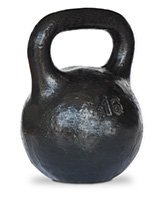
Apply It: Add the suitcase carry to your next workout. Grab a heavy kettlebell or dumbbell (45 pounds is a good starting weight) and walk forward and backward for 30-75 seconds.
"The asymmetrical load works your obliques—which are important for lateral core strength—as well as your glutes, which are essential for athletic power," says McGill.
New Way /// Personalize Your Rest
Trainers know that exercise affects everyone differently, and Brazilian researchers recently confirmed that notion when they found that people differ significantly in their recovery needs. Without proper recovery, performance suffers, especially if you're doing circuits.
"Use a heart rate monitor to customize your rest," says Rachel Cosgrove, co-owner of Results Fitness in California. "Waiting until your heart rate reaches a certain level results in true recovery between work periods, which is particularly beneficial for losing weight."


Apply It: Determine your maximum heart rate: Multiply your age by 0.7 and then subtract that number from 207. Then strap on a heart rate monitor and track your pulse between circuits.
When it drops to 75 percent of your maximum, begin your next one. "Your rest periods will become longer the farther you get into your workout," says Cosgrove. "But your form—and performance—should be better throughout."

